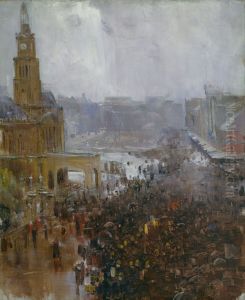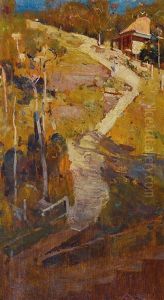Arthur Streeton Paintings
Arthur Streeton was an eminent Australian landscape painter, born on April 8, 1867, in Mount Duneed, Victoria, Australia. He is best known for his vibrant and luminous depictions of the Australian landscape, which have come to symbolize the national visual identity of Australia during the late 19th and early 20th centuries. Streeton was a key member of the Heidelberg School, a movement that is considered to be the first distinctively Australian school of painting, with its members committed to exploring and portraying the unique light, color, and atmosphere of the Australian bush.
Streeton's early work was characterized by plein air painting, capturing the essence of the Australian sunlight and its effects on the natural surroundings. His technique involved quick, fluent brushstrokes that effectively conveyed the brightness and clarity of the Australian light. One of his most famous works, 'Golden Summer, Eaglemont' (1889), is a prime example of his ability to portray the intense heat and luminosity of the Australian landscape, a theme that would remain prevalent throughout his career.
In 1886, Streeton met fellow artists Tom Roberts and Charles Conder, with whom he would collaborate and exhibit. The trio, along with others, participated in the seminal 9 by 5 Impression Exhibition in 1889, which featured works painted on the lids of cigar boxes, roughly 9 by 5 inches in size. This exhibition marked a defining moment in the development of Australian Impressionism and brought greater public attention to Streeton's work.
Streeton's success continued to grow, and his paintings were exhibited in Australia and abroad. In the 1890s, he traveled to England and Europe, where he was exposed to a wider range of artistic influences and continued to develop his style. During World War I, he served with the Australian Imperial Force and was appointed an official war artist. His wartime experiences influenced some of his later work, which included evocative landscapes scarred by conflict.
After the war, Streeton returned to Australia and continued to paint, achieving significant recognition and success. He was knighted in 1937 for his services to art. Throughout his career, Streeton's work displayed a consistent fascination with the Australian landscape, and he remained a passionate advocate for the environment and conservation. He died on September 1, 1943, in Olinda, Victoria, leaving a legacy as one of Australia's most celebrated and influential artists.



























